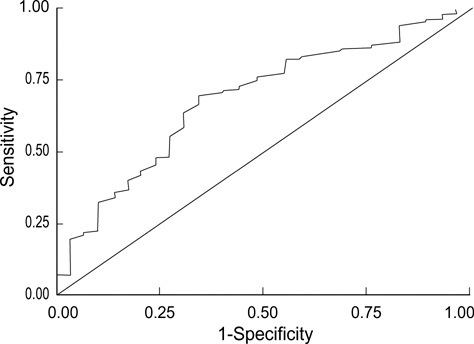J Korean Med Sci.
2005 Dec;20(6):1006-1010. 10.3346/jkms.2005.20.6.1006.
Risk Factors of Voiding Dysfunction and Patient Satisfaction After Tension-free Vaginal Tape Procedure
- Affiliations
-
- 1Department of Urology, University of Ulsan College of Medicine, Asan Medical Center, Seoul, Korea. MSChoo@amc.seoul.kr
- 2Department of Urology, Sungkyunkwan University School of Medicine, Samsung Medical Center, Seoul, Korea.
- KMID: 2157753
- DOI: http://doi.org/10.3346/jkms.2005.20.6.1006
Abstract
- This study was undertaken to identify risk factors for postoperative voiding dysfunction and factors having impact on patient global satisfaction after a tension-free vaginal tape (TVT) procedure. Two hundred and eighty-five women who underwent the TVT procedure for stress urinary incontinence were analyzed to identify risk factors predictive of voiding dysfunction. Postoperative voiding dysfunction was defined as a peak urinary flow rate (PFR) <10 mL/sec (straining voiding, n=17) or residual urine volume >30% of bladder capacity (incomplete emptying, n=13). The global satisfaction rate was 91.6%. Voiding dysfunction developed in 29 (10.2%) patients. Among the factors, PFR was only factor of significance for voiding dysfunction. There was no significant difference between patients with and without voiding dysfunction in terms of their satisfaction. But postoperative PFR <10 mL/sec significantly compromised global satisfaction after the surgery. In those patients with a preoperative PFR <20 mL/sec, there were more patients with postoperative PFR <10 mL/sec. Peak urinary flow rate is an important factor for the postoperative voiding dysfunction. The inevitable decline in PFR can compromise patients' satisfaction with the procedure, when their postoperative PFR was <10 mL/sec.
Keyword
MeSH Terms
Figure
Cited by 1 articles
-
A Long-Term Study of the Effects of the Tension-Free Vaginal Tape Procedure for Female Stress Urinary Incontinence on Voiding, Storage, and Patient Satisfaction: A Post-Hoc Analysis
Ji-Yeon Han, Cheryn Song, Junsoo Park, Hee Chang Jung, Kyu-Sung Lee, Myung-Soo Choo
Korean J Urol. 2010;51(1):40-44. doi: 10.4111/kju.2010.51.1.40.
Reference
-
1. DeLancey JO. Structural support of the urethra as it relates to stress urinary incontinence: the hammock hypothesis. Am J Obstet Gynecol. 1994. 170:1713–1720.
Article2. Ulmsten U, Henriksson L, Johnson P, Varhos G. An ambulatory surgical procedure under local anesthesia for treatment of female urinary incontinence. Int Urogynecol J Pelvic Floor Dysfunct. 1996. 7:81–85.
Article3. Ward KL, Hilton P, Browning J. A randomized trial of colposuspension and tension-free vaginal tape (TVT) for primary genuine stress incontinence. Neurourol Urodyn. 2000. 19:386–388.4. Bidmead J, Cardozo L. Sling techniques in the treatment of genuine stress incontinence. BJOG. 2000. 107:147–156.
Article5. Leach GE, Dmochowski RR, Appell RA, Blaivas JG, Hadley HR, Luber KM, Mostwin JL, O'Donnell PD, Roehrborn CG. Female stress urinary incontinence clinical guidelines panel summary report on surgical management of female stress urinary incontinence. J Urol. 1997. 158:875–880.
Article6. Sander P, Moller LM, Rudnicki PM, Lose G. Does the tension-free vaginal tape procedure affect the voiding phase? Pressure-flow studies before and 1 year after surgery. BJU Int. 2002. 89:694–698.
Article7. Ulmsten U, Johnson P, Rezapour M. A three-year follow up of tension free vaginal tape for surgical treatment of female stress urinary incontinence. Br J Obstet Gynaecol. 1999. 106:345–350.
Article8. Olsson I, Kroon U. A three-year postoperative evaluation of tension-free vaginal tape. Gynecol Obstet Invest. 1999. 48:267–269.
Article9. Stamey TA. Endoscopic suspension of the vesical neck for urinary incontinence in female. Report on 203 consecutive patients. Ann Surg. 1980. 192:465–471.10. Abrams P, Blaivas JG, Stanton SL, Andersen JT. The standardisation of terminology of lower urinary tract function. The international continence society committee on standardisation of terminology. Scand J Urol Nephrol Suppl. 1998. 114:5–19.11. Lose G, Jorgensen L, Mortensen SO, Molsted-Pedersen L, Kristensen JK. Voiding difficulties after colposuspension. Obstet Gynecol. 1987. 69:33–38.
Article12. Boustead GB. The tension-free vaginal tape for treating female stress urinary incontinence. BJU Int. 2002. 89:687–693.
Article13. Hong B, Park S, Kim HS, Choo MS. Factors predictive of urinary retention after a tension-free vaginal tape procedure for female stress urinary incontinence. J Urol. 2003. 170:852–856.
Article14. Groutz A, Gordon D, Lessing JB, Wolman I, Jaffa A, David MP. Prevalence and characteristics of voiding difficulties in women: are subjective symptoms substantiated by objective urodynamic data? Urology. 1999. 54:268–272.
Article15. Stanton SL, Ozsoy C, Hilton P. Voiding difficulties in the female: prevalence, clinical and urodynamic review. Obstet Gynecol. 1983. 61:144–147.16. Wang KH, Wang KH, Neimark M, Davila GW. Voiding dysfunction following TVT procedure. Int Urogynecol J Pelvic Floor Dysfunct. 2002. 13:353–357.
Article
- Full Text Links
- Actions
-
Cited
- CITED
-
- Close
- Share
- Similar articles
-
- Non-surgical Treatment of Voiding Dysfunction Following Tension-Free Vaginal Tape Procedure in Female Stress Urinary Incontinence
- The Effect of Tape-tension Change on Outcome of Tension-free Vaginal Tape Procedure and Voiding Function
- Risk Factors Predicting Voiding Difficulty Following Tension-Free Vaginal Tape Procedure
- Incidence and Risk Factors of Postoperative De Novo Voiding Dysfunction following Midurethral Sling Procedures
- Surgical Treatment for Long Term Urethral Obstruction after Tension-Free Vaginal Tape Procedure


